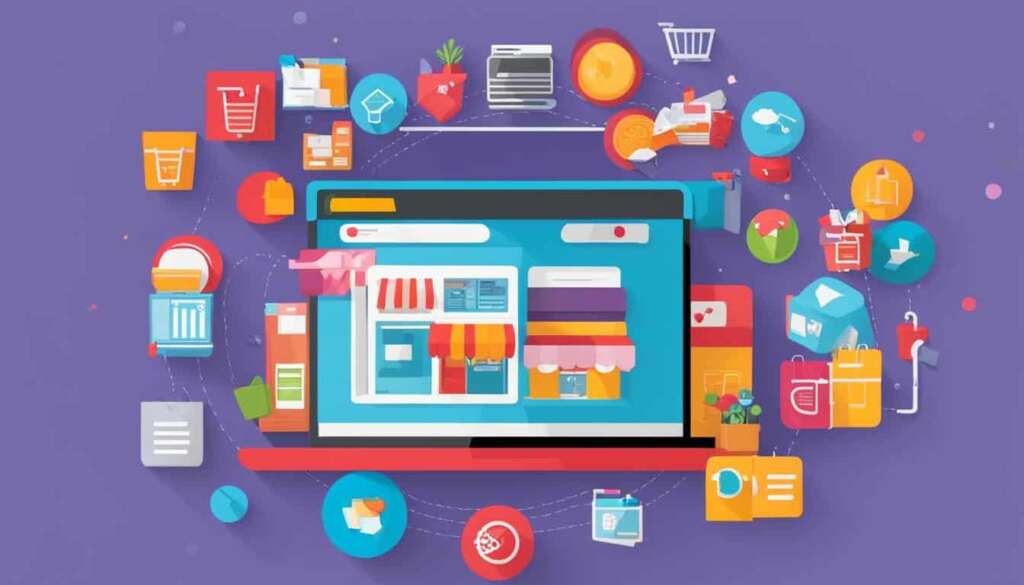Table of Contents
E-commerce has become a powerhouse in the world of retail, with explosive growth in recent years. To stand out in this competitive landscape, digital marketing has become crucial for online businesses. This comprehensive guide will explore the importance of digital marketing in e-commerce, the key features and strategies of e-commerce digital marketing, and the advantages of e-commerce.
In today’s digital age, having a strong online presence is essential for the success of your e-commerce business. Digital marketing strategies can help drive traffic to your website, boost sales, and grow your brand. By harnessing the power of digital marketing, you can reach a wider audience and connect with your target customers more effectively.
One of the primary goals of e-commerce marketing is to increase online visibility and attract potential customers to your website. This can be achieved through search engine optimization (SEO), which involves optimizing your website’s content and structure to improve its ranking in search engine results.
Additionally, digital marketing allows you to implement targeted advertising campaigns that reach the right audience at the right time. By utilizing platforms such as social media, email marketing, and pay-per-click advertising, you can tailor your messaging to resonate with your target customers and increase the likelihood of conversion.
Furthermore, incorporating analytics and tracking tools into your digital marketing strategy provides valuable insights into customer behavior, allowing you to make data-driven decisions to optimize your campaigns and improve overall performance.
As the e-commerce industry continues to evolve, staying up-to-date with the latest trends and technologies in digital marketing is crucial. By adopting a customer-centric approach, optimizing your website, and employing effective digital marketing strategies, you can position your e-commerce business for long-term success and growth.
In the following sections, we will delve deeper into the importance of digital marketing in e-commerce, the key features and strategies, different types of e-commerce, and essential tips for achieving online success. Let’s unlock the essentials of e-commerce marketing and pave the way to your online success.
Understanding the Importance of Digital Marketing
Digital marketing plays a pivotal role in the success of e-commerce businesses. Its ability to reach a global audience, cost-effectiveness, measurability, and targeted approach make it an indispensable tool for online marketers.
Firstly, digital marketing enables e-commerce businesses to reach a vast global audience. With the internet being accessible worldwide, businesses can expand their reach beyond geographical boundaries and connect with potential customers from different corners of the globe.
Moreover, digital marketing offers a cost-effective solution compared to traditional advertising methods. Online platforms provide a range of marketing channels, such as social media, email marketing, and pay-per-click advertising, which allow businesses to invest their marketing budget wisely and maximize their return on investment.
Furthermore, digital marketing offers the advantage of real-time tracking and measurement. Businesses can monitor the performance of their marketing campaigns in real-time, allowing them to make data-driven decisions and optimize their strategies for better results. This level of visibility and control helps businesses refine their marketing efforts and achieve higher levels of effectiveness.
In addition, digital marketing provides the ability to target ideal customers. Through techniques such as search engine optimization, social media targeting, and email segmentation, businesses can tailor their marketing messages to a specific audience. By reaching the right people with personalized content, businesses can increase their conversion rates and drive more qualified leads.
Digital marketing allows e-commerce businesses to tap into the immense potential of the online landscape, reaching a global audience, optimizing costs, measuring campaign effectiveness, and precisely targeting their ideal customers.
Real-time Tracking and Measurable Results
A primary advantage of digital marketing in e-commerce is the ability to track and measure the effectiveness of marketing campaigns in real time. Through analytics tools, businesses can gain valuable insights into customer behavior, campaign performance, and website metrics. This data-driven approach helps businesses refine their strategies, optimize conversion rates, and improve overall marketing effectiveness.
Target Ideal Customers
Digital marketing allows e-commerce businesses to target their ideal customers with precision. By leveraging techniques such as search engine optimization, social media targeting, and email segmentation, businesses can tailor their marketing messages to specific demographics, interests, and behaviors. This targeted approach ensures that businesses reach the right audience with the right message, maximizing the chances of conversion and driving revenue.
Cost-effectiveness and Reach
Compared to traditional advertising methods, digital marketing offers cost-effectiveness and a wider reach. With various online platforms and channels available, businesses can choose the most suitable options for their marketing objectives and budget. This flexibility allows businesses to optimize their marketing spend and allocate resources where they are most impactful, resulting in a higher return on investment.
The Features of E-commerce Digital Marketing
E-commerce digital marketing is a multifaceted approach that incorporates various features and strategies to optimize online businesses for success. By leveraging the power of digital marketing, businesses can enhance their online visibility, attract a wider audience, and drive more conversions. In this section, we will explore the key features of e-commerce digital marketing and how they contribute to the overall success of an online business.
1. Search Engine Optimization (SEO)
Search Engine Optimization plays a crucial role in improving website visibility and driving organic traffic. By optimizing website content and structure, businesses can enhance their search engine rankings, making it easier for potential customers to find their products or services.
2. Keyword Research
Keyword research is a fundamental aspect of e-commerce digital marketing. By identifying relevant keywords and incorporating them into website content, businesses can attract targeted traffic and improve their search engine rankings. A comprehensive keyword research strategy helps businesses optimize their online presence and increase their chances of being discovered by potential customers.
3. Content Marketing
Content marketing involves creating and sharing valuable content to attract and educate customers. By producing high-quality content, such as blog posts, articles, and videos, businesses can establish themselves as industry authorities and build trust with their audience. Effective content marketing not only drives traffic but also encourages engagement, brand loyalty, and conversions.
4. Social Media Marketing
Social media marketing is a powerful tool for promoting products, engaging with customers, and building a strong online presence. By leveraging popular social media platforms, businesses can reach a wider audience, foster meaningful relationships, and encourage word-of-mouth marketing. Social media marketing allows businesses to create targeted campaigns, interact with customers in real-time, and showcase their products or services through visually compelling content.
5. Email Marketing
Email marketing is an effective way to nurture customer relationships and drive conversions. By sending personalized and relevant emails to subscribers, businesses can keep their audience engaged, promote new products or offers, and build brand loyalty. Email marketing automation tools enable businesses to segment their audience, track open rates and click-through rates, and deliver tailored content to maximize engagement.
6. Pay-per-click Advertising
Pay-per-click (PPC) advertising allows businesses to display ads at the top of search engine results pages, reaching a highly targeted audience. By bidding on relevant keywords, businesses can drive instant traffic to their websites and increase brand exposure. PPC advertising platforms, such as Google Ads, provide robust targeting options, ad performance tracking, and conversion tracking to optimize campaign effectiveness.
7. Shopping Ads
Shopping ads, also known as product listing ads, are an effective way to showcase products directly in search engine results pages. By displaying product images, prices, and descriptions, businesses can drive qualified traffic and increase the likelihood of sales. Shopping ads are highly visual and provide users with valuable information upfront, making them a popular choice for e-commerce businesses.
8. Remarketing
Remarketing allows businesses to re-engage with website visitors who have shown interest but haven’t made a purchase. By targeting these users with tailored ads, businesses can stay top-of-mind, reinforce their brand messaging, and increase the chances of converting them into customers. Remarketing campaigns can be set up through various platforms, including display networks and social media platforms.
9. Conversion Rate Optimization
Conversion rate optimization (CRO) focuses on improving website performance and increasing the percentage of website visitors who complete desired actions, such as making a purchase or filling out a form. By analyzing user behavior, conducting A/B testing, and optimizing website design and user experience, businesses can enhance their conversion rates and maximize the value of their website traffic.
10. Influencer Marketing
Influencer marketing involves collaborating with influential individuals who have a significant following and can endorse a brand or product. By partnering with relevant influencers, businesses can tap into their audience’s trust and leverage their influence to reach a broader customer base. Influencer marketing is particularly effective for building brand awareness, driving traffic, and generating authentic product recommendations.
11. Affiliate Marketing
Affiliate marketing is a performance-based marketing strategy where businesses reward affiliates for each customer or visitor they bring to the website. By partnering with affiliates, businesses can expand their reach, leverage the affiliates’ promotional efforts, and increase the chances of conversions. Affiliate marketing is a cost-effective way to drive traffic and boost sales, as businesses only pay for actual results.
12. Analytics and Tracking
Analytics and tracking are essential elements of e-commerce digital marketing. By using analytics tools and tracking platforms, businesses can collect and analyze valuable data to make informed decisions. Analytics provides insights into user behavior, website performance, conversion rates, and campaign effectiveness, allowing businesses to refine their marketing strategies and optimize their online presence.
Types of E-commerce
When it comes to e-commerce, there are several distinct models that cater to different types of transactions and target audiences. Understanding these various types of e-commerce is fundamental for businesses looking to establish a strong online presence and choose the most suitable approach for their specific needs. Let’s explore the key categories of e-commerce:
B2C (Business-to-Consumer)
B2C e-commerce, also known as business-to-consumer, involves businesses selling products or services directly to individual consumers. This is the most common form of e-commerce, where customers browse and purchase from an online store owned by a business. Examples of popular B2C platforms include Amazon, eBay, and Asos.
B2B (Business-to-Business)
B2B e-commerce refers to transactions between businesses, where products or services are sold from one business to another. It typically involves larger order volumes and more complex sales processes. B2B e-commerce platforms often offer features such as bulk ordering, account management, and custom pricing. Well-known B2B marketplaces include Alibaba, ThomasNet, and SAP Ariba.
C2C (Consumer-to-Consumer)
C2C e-commerce enables individuals to sell products or services directly to other individuals through online platforms. These platforms act as intermediaries and provide a secure environment for transactions to take place. Examples of popular C2C platforms include eBay, Etsy, and Depop.
C2B (Consumer-to-Business)
C2B e-commerce is where individuals offer products or services to businesses. This can include freelancers, influencers, or individual creators providing their expertise or unique products to companies. Common examples of C2B transactions include sponsored content, social media collaborations, and customer feedback or review services.
D2C (Direct-to-Consumer)
D2C e-commerce involves brands or manufacturers selling their products directly to consumers, bypassing traditional retail channels. This allows brands to have more control over the customer experience, from product development to marketing and distribution. Popular D2C brands include Glossier, Warby Parker, and Dollar Shave Club.
M-Commerce (Mobile Commerce)
M-Commerce refers to e-commerce transactions conducted through mobile devices such as smartphones and tablets. With the increasing usage of mobile devices, optimizing websites and platforms for mobile compatibility is crucial for businesses. Mobile apps and mobile-optimized websites make it more convenient for users to browse, shop, and make purchases on the go.
Dropshipping
Dropshipping is a business model where online retailers don’t keep inventory in stock. Instead, they partner with suppliers who fulfill the orders directly to customers. Dropshipping eliminates the need for retailers to handle inventory management and shipping logistics. Shopify, WooCommerce, and Oberlo are popular platforms for dropshipping businesses.
| Type of E-commerce | Description | Examples |
|---|---|---|
| B2C | Business-to-Consumer | Amazon, eBay |
| B2B | Business-to-Business | Alibaba, ThomasNet |
| C2C | Consumer-to-Consumer | eBay, Etsy |
| C2B | Consumer-to-Business | Influencer collaborations, freelance services |
| D2C | Direct-to-Consumer | Glossier, Warby Parker |
| M-Commerce | Mobile Commerce | Mobile apps, mobile-optimized websites |
| Dropshipping | Inventory-free online retail | Shopify, WooCommerce |
Conclusion
In the rapidly evolving world of e-commerce, achieving success is contingent upon several key factors. First and foremost, optimizing your website for a seamless customer experience is paramount. Ensuring that your website is user-friendly, responsive, and visually appealing will not only attract more visitors but also keep them engaged and encourage conversions.
Digital marketing plays a crucial role in driving traffic to your e-commerce website and boosting sales. With the plethora of online marketing strategies available, it’s important to adopt a customer-centric approach that focuses on understanding and meeting the needs of your target audience. Through targeted advertising, personalized promotions, and engaging content, you can establish meaningful connections with your customers and foster long-term loyalty.
A streamlined fulfillment process is also vital in achieving e-commerce success. By ensuring efficient inventory management, reliable shipping methods, and prompt customer service, you can provide a seamless end-to-end experience that leaves your customers satisfied and likely to return.
Lastly, leveraging analytics and sales data is essential for making informed decisions and driving continuous improvement. By monitoring and analyzing key metrics such as conversion rates, customer behavior, and sales trends, you can identify areas for optimization and capitalize on opportunities for growth.
To thrive in the competitive e-commerce landscape, it’s crucial to stay abreast of emerging trends and technologies. Embrace innovation, adapt to evolving customer preferences, and continually refine your strategies to stay ahead of the curve. By incorporating website optimization, digital marketing, a customer-centric approach, a streamlined fulfillment process, and data-driven decision making, you can position your e-commerce business for sustained growth and prosperity.
FAQ
Why is digital marketing important in e-commerce?
Digital marketing is important in e-commerce because it helps drive traffic to your online store, boost sales, and grow your brand.
What are the key features of e-commerce digital marketing?
The key features of e-commerce digital marketing include search engine optimization (SEO), keyword research, content marketing, social media marketing, email marketing, pay-per-click advertising, shopping ads, remarketing, conversion rate optimization, influencer marketing, affiliate marketing, and analytics and tracking.
What are the different types of e-commerce?
The different types of e-commerce include B2C (business-to-consumer), B2B (business-to-business), C2C (consumer-to-consumer), C2B (consumer-to-business), D2C (direct-to-consumer), M-Commerce (mobile commerce), and dropshipping.
How can I achieve e-commerce success?
To achieve e-commerce success, it’s important to optimize your website for a seamless customer experience, embrace the power of digital marketing, adopt a customer-centric approach, streamline your fulfillment process, and leverage analytics and sales data for informed decisions.













